#jame's prunier
Explore tagged Tumblr posts
Text
Famous Five Art Nostalgia – Summer Special (2/3): Camping
Introductory post
Masterpost
Be it in a tent, a caravan or even a cave, on a mountain ⛰️, on the moor 🍃 or by a lake 🏞️, how better to enjoy nature than camping 🏕️? And once night falls 🌜, come gather around the campfire 🔥 before bundling up in a cosy sleeping bag 😴!

Simone Baudouin, #03 Five Run Away Together, 1955
Click for more!

Simone Baudouin, #03 Five Run Away Together, 1955

Simone Baudouin, #03 Five Run Away Together, 1955

Simone Baudouin, #08 Five Get Into Trouble, 1957

Paul Durand, #07 Five Go Off To Camp, 1957

Paul Durand, #07 Five Go Off To Camp, 1957

Paul Durand, #07 Five Go Off To Camp, 1957

Paul Durand, #07 Five Go Off To Camp, 1957

Simone Baudouin, #10 Five On A Hike Together, 1958

Jeanne Hives, #08 Five Get Into Trouble, 1962

Jeanne Hives, #16 Five Go To Billycock Hill, 1962

Jean Sidobre, #21 Five Are Together Again, 1973

Jean Sidobre, #05 Five Go Off In A Caravan, 1976

Jean Sidobre, #05 Five Go Off In A Caravan, 1976

Jean Sidobre, #07 Five Go Off To Camp, 1977

Jean Sidobre, #07 Five Go Off To Camp, 1977

Jean Sidobre, #07 Five Go Off To Camp, 1977

Claude Pascal, #LC21 Les Cinq jouent serré, 1980

Claude Pascal, #LC21 Les Cinq jouent serré, 1980

Umberto Nonna, #08 Five Get Into Trouble, 1981

Umberto Nonna, #15 Five On A Secret Trail, 1981

Jeann Sidobre, #16 Five Go To Billycock Hill, 1983

Annie-Claude Martin, #03 Five Run Away Together, 1984

Anne Bozellec, #03 Five Run Away Together, 1991

Anne Bozellec, #LC01 Les Cinq sont les plus forts, 1997

Philippe Munch and Jame’s Prunier, #07 Five Go Off To Camp, 2000

Frédéric Rébéna, #LC21 Les Cinq jouent serré, 2014

Auren, #07 Five Go Off To Camp, 2019

Auren, #LC01 Les Cinq sont les plus forts, 2021
#papillon82 reads#famous five art nostalgia#famous five#le club des cinq#enid blyton#les cinq#claude voilier#illustrations#simone baudouin#paul durand#jeanne hives#jean sidobre#umberto nonna#anne bozellec#philippe munch#jame's prunier#frédéric rébéna#auren#annie-claude martin#claude pascal#summer special
3 notes
·
View notes
Photo

Welcome to 1968! Why not enjoy some PRUNIER-PRUNIER Extra Special at St. James Restaurant Ltd? http://menus.nypl.org/menus/26373
0 notes
Text

I'm a big big big fan of "le livre des Etoiles"
And this is my favourite character!!!! Anyway I spent five minutes laughing at his outfit. So I did a quick analysis of book two cover art.
I though he was so cool when I was 10.
illustration: Philippe Munch et Jame’s Prunier
#le livre des etoiles#spoiler in the tags but no one cares#the book of stars#yorwan#seigneur sha#the lack of tags is sending me#me and my obscure french obsessions#GO BRITTANY!#i love that I forgot the ? at the end of mediaeval undergarment#sorry Yorwan I guess I exposed you there
4 notes
·
View notes
Photo


Samedi
Pardon à celles/ceux qui aiment des posts que je supprime aussitôt. Je reprends : tandis que ma famille franco-nippone célèbre le Nouvel An dans le respect des traditions culturelles, spirituelles et gastronomiques japonaises, je regarde passer les avions avec l’espoir, de plus en plus ténu, de prendre dans 102 jours celui qui m’emportera vers mes amours via Paris et Osaka. En attendant, j’observe l’écoulement de l’eau, celui du temps, offre mon visage au soleil, lis en parallèle O pruniers en fleur, de Ryôkan, et New Iberia blues, de James Lee Burke, et finis les bouteilles de vin blanc liquoreux ouvertes pour les fêtes et gardées au frais (= le plus avouable de mes péchés).
9 notes
·
View notes
Text
Ridgemont Equity Partners Invests In Backstage
Ridgemont Equity Partners invests in Backstage. Backstage is a total platform that enables productions, brands, marketing agencies, and businesses to find and work with creative talent.
Jack Purcell of Ridgemont said: ‘Ridgemont is focused on identifying data, information, and marketing services investments with strong growth prospects across industries. We are impressed with Backstage’s outstanding leadership team, unparalleled subscriber growth, user engagement, platform traffic, and the vibrant level of activity on each side of its marketplace as content creators of all types engage with creative talent.’
Josh Ellstein of Backstage said: ‘Backstage has been a trusted brand in the performing arts world since 1960 and we have transformed it from a beloved, traditional trade publication to a modern career platform for performing artists and content producers. Our team built the industry’s most liquid two-sided marketplace that enables our users to get cast through casting directors, top brands, marketing agencies, and independent content producers. Ridgemont’s investment and strategic guidance will enable us to execute our shared vision for the next phase of development for Backstage and continue to meet the evolving needs of our users and the dynamic content industry.’
Mike Felman of Backstage added: ‘We built a platform to deliver efficiency to both sides of the marketplace and to help the large market of talent and creators be successful. This has resulted in significant growth and a compelling value proposition to creative talent and content creators. With three million people visiting the platform every month, 50,000 content creators posting opportunities during the last year, and a growing subscriber base, we are committed to serving as the preeminent source for information, professional development opportunities, and community engagement for talent and a valuable, efficient, and cost-effective tool for content creators of all types.’
Veteran digital media executive James Yaffe, and Cannondale Capital Investors took part in the deal and will serve on the Board. Former Executive Chairman of Backstage, Peter Rappaport also took part in the deal and continues as Strategic Advisor and Director.
Financing for the deal was provided by Audax Private Debt. Kirkland & Ellis and Barnes & Thornburg provided legal services to Ridgemont. Petsky Prunier Securities served as financial advisor. Blank Rome and Gibson, Dunn & Crutcher provided legal services to Backstage.
1 note
·
View note
Photo

TIE fighters vs Boeing B-17 Flying Fortress (upgrade illustration from amazing book "Jame's Prunier: Le livre des pilotes de l'ender, Histoire de l'aviation/3")
5 notes
·
View notes
Photo

La place Stanislas par le peintre Jame’s Prunier https://www.instagram.com/p/BrvZvRnF47X/?utm_source=ig_tumblr_share&igshid=jf164qmqyaku
0 notes
Text
Famous Five Art Nostalgia – Character Portrait: Anne [Annie]
Introductory post
Masterpost
Character profile (adapted from Wikipedia):
Anne is the youngest in the group, and generally takes care of the domestic duties during the Five's various camping holidays. As the youngest (ten years old in the first book of the series), she is more likely than the others to be frightened, and does not really enjoy the adventures as much as her brothers and her cousin. She sometimes lets her tongue run away with her, but ultimately she is as brave and resourceful as the others. She likes doing the domestic things such as planning, organising and preparing meals, and keeping where they are staying clean and tidy, be it a cave, house, tent or caravan. In Smuggler's Top it is suggested she is claustrophobic, as she is frightened of enclosed spaces, which remind her of bad dreams. But the adventures invariably lead the Five into tunnels, down wells, and into dungeons and other enclosed spaces, demonstrating how brave she really is.
Anne keeps the same general characterisation in Claude Voilier’s continuation series ‘Les Cinq’, although she occasionally insists that her brothers and cousin take part in household-y chores.

Eileen A. Soper, #03 Five Run Away Together, 1944
Click below for more portraits from every illustrator I could find!
(in chronological order)

Simone Baudouin, #02 Five Go Adventuring Again, 1955

Simone Baudouin, #03 Five Run Away Together, 1955

Paul Durand, #07 Five Go Off to Camp, 1957

Paul Durand, #07 Five Go Off to Camp, 1957

Aldo de Amicis, #12 Five Go Down To The Sea, 1959

Jeanne Hives, #13 Five Go To Mystery Moor, 1961

Jeanne Hives, #19 Five Go To Demon’s Rocks, 1963

Jeanne Hives, #19 Five Go To Demon’s Rocks, 1963

Jeanne Hives, #20 Five Have A Mystery To Solve, 1966

Jeanne Hives, #08 Five Get Into Trouble, 1969

Jean Sidobre, #19 Five Go To Demon’s Rocks, 1975

Jean Sidobre, #10 Five On A Hike Together, 1976

Claude Pascal, #LC14 Les Cinq vendent la peau de l’ours, 1977

Claude Pascal, #LC14 Les Cinq vendent la peau de l’ours, 1977

Claude Pascal, #LC19 Les Cinq en croisière, 1980

Buci, #LC21 Les Cinq contre les fantômes, 1981

Umberto Nonna, #15 Five On A Secret Trail, 1981

Jean Sidobre, #14 Five Have Plenty Of Fun, 1983

Annie-Claude Martin, #LC22 Les Cinq en Amazonie, 1983

Yves Beaujard, #21 Five Are Together Again, 1988

Anne Bozellec, #03 Five Run Away Together, 1991

Paul Gillon, #16 Five Go To Billycock Hill, 1994

Philippe Munch and Jame’s Prunier, #16 Five Go To Billycock Hill, 1999

Philippe Munch and Jame’s Prunier, #20 Five Have A Mystery To Solve, 2001

Frédéric Rébéna, #05 Five Go Off In A Caravan, 2010

Auren, #LC03 Le marquis appelle les Cinq / Les Cinq mènent l’enquête, 2022
~~~~~~
Thanks for reading!
#papillon82 reads#famous five art nostalgia#famous five#le club des cinq#enid blyton#les cinq#claude voilier#character portrait#illustrations#eileen soper#simone baudouin#paul durand#aldo de amicis#jeanne hives#jean sidobre#yves beaujard#paul gillon#anne bozellec#philippe munch#jame's prunier#frédéric rébéna#auren#annie-claude martin#claude pascal#buci#umberto nonna
4 notes
·
View notes
Text
Famous Five Art Nostalgia – Character Portrait: Timothy [Dagobert]
Introductory post
Masterpost
Character profile (adapted from Wikipedia):
Timothy, a.k.a. Tim or Timmy, is George's faithful dog. He is a large, brown mongrel with a long tail. George adopted him after finding him abandoned on the moors as a puppy. He is very friendly; he is clever, affectionate and loyal to the children and to George in particular; he provides physical protection for them many times. Timmy's presence is frequently given as the reason the children's parents allow them to wander unsupervised. George adores Timmy and thinks that he is the best dog in the world, and often becomes furious when people insult or threaten him. In the first book of the series, George's parents have forbidden her to keep Timmy, and she is forced to hide him with a fisher boy in the village. After the end of the Five's first adventure, her parents relent and she is allowed to keep him in the house and also take him with her to boarding school. It is a notable feature of the stories that Timmy's thoughts and feelings are frequently described.
In Claude Voilier’s continuation series ‘Les Cinq’, Timmy’s characterisation is fairly consistent with the original series – although some of his tracking feats frankly defy common sense!

Eileen A. Soper, #13 Five Go To Mystery Moor, 1954
Click below for more portraits from every illustrator I could find!
(in chronological order)

Simone Baudouin, #02 Five Go Adventuring Again, 1955

Simone Baudouin, #02 Five Go Adventuring Again, 1955

Simone Baudouin, #06 Five On Kirrin Island Again, 1956

Paul Durand, #07 Five Go Off To Camp, 1957

Paul Durand, #07 Five Go Off To Camp, 1957

Aldo de Amicis, #12 Five Go Down To The Sea, 1959

Jeanne Hives, #13 Five Go To Mystery Moor, 1961

Jeanne Hives, #01 Five On A Treasure Island, 1962

Jean Sidobre, #02 Five Go Adventuring Again, 1975

Jean Sidobre, #17 Five Get Into A Fix, 1975

Claude Pascal, #LC20 Les Cinq jouent serré, 1980

Umberto Nonna, #18 Five On Finniston Farm, 1981

Buci, #LC21 Les Cinq contre les fantômes, 1981

Jean Sidobre, #02 Five Go Adventuring Again, 1982

Annie-Claude Martin, #LC22 Les Cinq en Amazonie, 1983

Yves Beaujard, #21 Five Are Together Again, 1988

Anne Bozellec, #LC01 Les Cinq sont les plus forts, 1991

Paul Gillon, #10 Five On A Hike Together, 1998

Philippe Munch and Jame’s Prunier, #02 Five Go Adventuring Again, 2000

Auren, #10 Five On A Hike Together, 2006

Frédéric Rébéna, #LC09 Les Cinq font de la brocante / Les Cinq et la statue inca, 2023
~~~~~~
Bonus: Timmy and rabbits: A (one-sided) love story!

Simone Baudouin, #06 Five On Kirrin Island Again, 1956

Simone Baudouin, #10 Five On A Hike Together, 1958

Jeanne Hives, #11 Five Have A Wonderful Time, 1960

Jeanne Hives, #01 Five On A Treasure Island, 1962

Jeanne Hives, #20 Five Have A Mystery To Solve, 1966

Jean Sidobre, #01 Five On A Treasure Island, 1971

Jean Sidobre, #06 Five On Kirrin Island Again, 1975

Umberto Nonna, #06 Five On Kirrin Island Again, 1981
~~~~~~
Thanks for reading!
#papillon82 reads#famous five art nostalgia#famous five#le club des cinq#enid blyton#les cinq#claude voilier#character portrait#illustrations#eileen soper#simone baudouin#paul durand#aldo de amicis#jeanne hives#jean sidobre#yves beaujard#paul gillon#anne bozellec#philippe munch#jame's prunier#frédéric rébéna#auren#annie-claude martin#claude pascal#buci#umberto nonna
2 notes
·
View notes
Text
Famous Five Art Nostalgia – Character Portrait: Julian [François]
Introductory post
Masterpost
Character profile (adapted from Wikipedia):
Julian is the oldest of the Five, cousin to George and elder brother to Dick and Anne. He is tall, strong and intelligent as well as caring, responsible and kind. His cleverness and reliability are often noted by Aunt Fanny. He is the leader of the group and is very protective towards Anne and sometimes, to her frustration, towards George. Twelve years old at the start of the series, Julian is the most mature of the group but, although well-meaning, his manner can at times come over as overbearing, pompous or priggish.
In Claude Voilier’s continuation series ‘Les Cinq’, Julian can often be found correcting Dick for his colloquialisms or cheeky barbs. Despite being the voice of caution, he can rarely stop his headstrong cousin George from acting recklessly.

Eileen A. Soper, #08 Five Get Into Trouble, 1949
Click below for more portraits from every illustrator I could find!
(in chronological order)

Simone Baudouin, #06 Five On Kirrin Island Again, 1955

Paul Durand, #07 Five Go Off To Camp, 1957

Aldo de Amicis, #12 Five Go Down To The Sea, 1959

Jeanne Hives, #08 Five Get Into Trouble, 1962

Jeanne Hives, #19 Five Go To Demon’s Rocks, 1963

Jeanne Hives, #20 Five Have A Mystery To Solve, 1966

Jeanne Hives, #15 Five On A Secret Trail, 1968

Jeanne Hives, #08 Five Get Into Trouble, 1969

Jean Sidobre, #LC07 Les Cinq contre le Masque Noir, 1974

Jean Sidobre, #07 Five Go Off To Camp, 1977

Jean Sidobre, #15 Five On A Secret Trail, 1977

Claude Pascal, #LC14 Les Cinq vendent la peau de l’ours, 1977

Jean Sidobre, #18 Five On Finniston Farm, 1979

Claude Pascal, #LC20 Les Cinq jouent serré, 1980

Umberto Nonna, #03 Five Run Away Together, 1981

Umberto Nonna, #18 Five On Finniston Farm, 1981

Buci, #LC21 Les Cinq contre les fantômes, 1981

Annie-Claude Martin, #LC24 Les Cinq contre le loup-garou, 1985

Yves Beaujard, #18 Five On Finniston Farm, 1988

Anne Bozellec, #03 Five Run Away Together, 1991

Paul Gillon, #07 Five Go Off To Camp, 1991

Philippe Munch and Jame’s Prunier, #16 Five Go To Billycock Hill, 1999

Frédéric Rébéna, #LC05 Les Cinq à la télévision, 2011

Auren, #09 Five Fall Into Adventure, 2019
~~~~~~
And as a bonus, here is probably my favourite scene featuring Julian when, in #03 Five Run Away Together, he masterfully faces off the Sticks who would have denied the Five their meal. Enjoy!

Eileen A. Soper, #03 Five Run Away Together, 1944

Simone Baudouin, #03 Five Run Away Together, 1955

Jean Sidobre, #03 Five Run Away Together, 1976

Annie-Claude Martin, #03 Five Run Away Together, 1984

Anne Bozellec, #03 Five Run Away Together, 1991
~~~~~~
Thanks for reading!
#papillon82 reads#famous five art nostalgia#famous five#le club des cinq#enid blyton#les cinq#claude voilier#character portraits#illustrations#eileen soper#simone baudouin#paul durand#aldo de amicis#jeanne hives#jean sidobre#umberto nonna#yves beaujard#paul gillon#philippe munch#jame's prunier#frédéric rébéna#auren#annie-claude martin#claude pascal#buci#anne bozellec
2 notes
·
View notes
Text
Famous Five Art Nostalgia – Character Portrait: Dick [Mick]
Introductory post
Masterpost
Character profile (adapted from Wikipedia):
Dick has a cheeky sense of humour, but is also dependable and kind in nature. He is the same age as his cousin George, a year younger than his brother Julian and a year older than his sister Anne – eleven at the start of the series. Though inclined to tease his sister at times, Dick is, like Julian, very caring towards Anne and does his best to keep her cheered up when she gets upset. He uses his wits and saves the Five in many adventures but probably has the least clearly-drawn character of the four cousins.
In Claude Voilier’s continuation series ‘Les Cinq’, his cheeky nature often comes out in the form of unmannerly colloquialisms or sassy barbs, for which Julian never fails to admonish him. Dick’s sweet tooth is also legendary.

Eileen A. Soper, #01 Five On A Treasure Island, 1942
Click below for more portraits from every illustrator I could find!
(in chronological order)

Simone Baudouin, #04 Five Go To Smuggler’s Top, 1956

Paul Durand, #07 Five Go Off To Camp, 1957

Paul Durand, #07 Five Go Off To Camp, 1957

Simone Baudouin, #10 Five On A Hike Together, 1958

Aldo de Amicis, #12 Five Go Down To The Sea, 1959

Eileen A. Soper, #18 Five On Finniston Farm, 1960

Jeanne Hives, #09 Five Fall Into Adventure, 1960

Jeanne Hives, #01 Five On A Treasure Island, 1962

Jeanne Hives, #08 Five Get Into Trouble, 1969

Jean Sidobre, #09 Five Fall Into Adventure, 1973

Jean Sidobre, #19 Five Go To Demon’s Rocks, 1975

Claude Pascal, #LC14 Les Cinq vendent la peau de l’ours, 1977

Claude Pascal, #LC19 Les Cinq en croisière, 1980

Claude Pascal, #LC20 Les Cinq jouent serré, 1980

Umberto Nonna, #02 Five Go Adventuring Again, 1981

Umberto Nonna, #08 Five Get Into Trouble, 1981

Buci, #LC21 Les Cinq contre les fantômes, 1981

Jean Sidobre, #01 Five On A Treasure Island, 1983

Annie-Claude Martin, #LC24 Les Cinq contre le loup-garou, 1985

Yves Beaujard, #20 Five Have A Mystery To Solve, 1988

Paul Gillon, #03 Five Run Away Together, 1991

Anne Bozellec, #03 Five Run Away Together, 1991

Anne Bozellec, #LC19 Les Cinq en croisière, 1995

Anne Bozellec, #LC22 Les Cinq en Amazonie, 1995

Philippe Munch and Jame’s Prunier, #01 Five On A Treasure Island, 1999

Frédéric Rébéna, #LC12 La fortune sourit aux Cinq / Les Cinq et la fortune des Saint-Maur, 2013

Auren, #14 Five Have Plenty Of Fun, 2020
~~~~~~
Thanks for reading!
#papillon82 reads#famous five art nostalgia#famous five#le club des cinq#enid blyton#les cinq#claude voilier#character portraits#illustrations#eileen soper#simone baudouin#paul durand#aldo de amicis#jeanne hives#jean sidobre#yves beaujard#paul gillon#anne bozellec#philippe munch#jame's prunier#frédéric rébéna#auren#annie-claude martin#claude pascal#buci#umberto nonna
2 notes
·
View notes
Text
Famous Five Art Nostalgia – Publishing Overview
Introductory post
When I started this series of posts a few months ago, I only had the vaguest idea about the various editions of the Famous Five books that existed over the years in France. The most well-known editions are those from the “Bibliothèque Rose” collection from publisher Hachette – ask anyone on the street (born in the last millennium) and it is probably what they have in mind. But through my searches on the second-hand market – both physical and online – I discovered several additional publications, and even the “Bibliothèque Rose” collection itself saw several variations over the years, giving us a plethora of cover art and inside illustrations to enjoy. Read on to get an overview of the publishing history of the Famous Five books in France (and French-speaking Switzerland)!
The French publisher, Hachette, was founded in 1826 by Louis Hachette as a bookshop and publishing company, first specialising in schoolbooks. In the 1850s, Louis Hachette opened several bookshops in railway stations and started to diversify his offer with serialised novels, travel books and magazines. In 1853, he signed a partnership with the Countess of Ségur (still famous to this day in the world of children’s literature) and subsequently founded the “Bibliothèque Rose” collection (lit. “pink library”) three years later, focused on books aimed to children aged 6-12. 150 years later, Hachette is now the first publishing company in France, and the “Bibliothèque Rose” collection still exists, although it has known many changes over the years.
The first Famous Five book was first published in France in 1955, under the simple title “Le Club des Cinq.” The French publisher did not follow the original English publishing order, and instead chose to publish in priority the books which, I assume, were deemed to garner most traction at the time. The first six books published in France have their original editions in a collection named “Ségur-Fleuriot” (thus named as an homage to two female writers whom Louis Hachette had been working with). These books were pocket-sized, with a hard cover, black-and-white illustrations, and a full-colour dust jacket.

“Ségur-Fleuriot” collection – From left to right:
#02 Five Go Adventuring Again / Le Club des Cinq (1955, ill. Simone Baudouin);
#03 Five Run Away Together / Le Club des Cinq contre-attaque (1955, ill. S. Baudouin);
#04 Five Go to Smuggler’s Top / Le Club des Cinq en vacances (1956, ill. S. Baudouin);
#06 Five Go On Kirrin Island Again / Le Club des Cinq joue et gagne (1956, ill. S. Baudouin);
#07 Five Go Off to Camp / Le Club des Cinq va camper (1957, ill. Paul Durand);
#08 Five Get into Trouble / Le Club des Cinq en péril (1957, ill. S. Baudouin).
(Note: The numbers starting with # correspond to the original English publishing order.)
From what I can gather – even if I find it odd because it doesn’t sound commercially sound – the next books benefitted from a double first edition: one in a collection called “Nouvelle Collection Ségur” with a soft cover, and the other in the above-mentioned “Bibliothèque Rose” with a hard cover. As far as I know, both these editions featured the same inside illustrations, although I have never seen a copy of a “Nouvelle Collection Ségur” book, so I cannot be absolutely sure of this. The red-coloured artwork featuring on the “Nouvelle Collection Ségur” covers were re-used (in black) on the inside title pages of the “Bibliothèque Rose” editions.
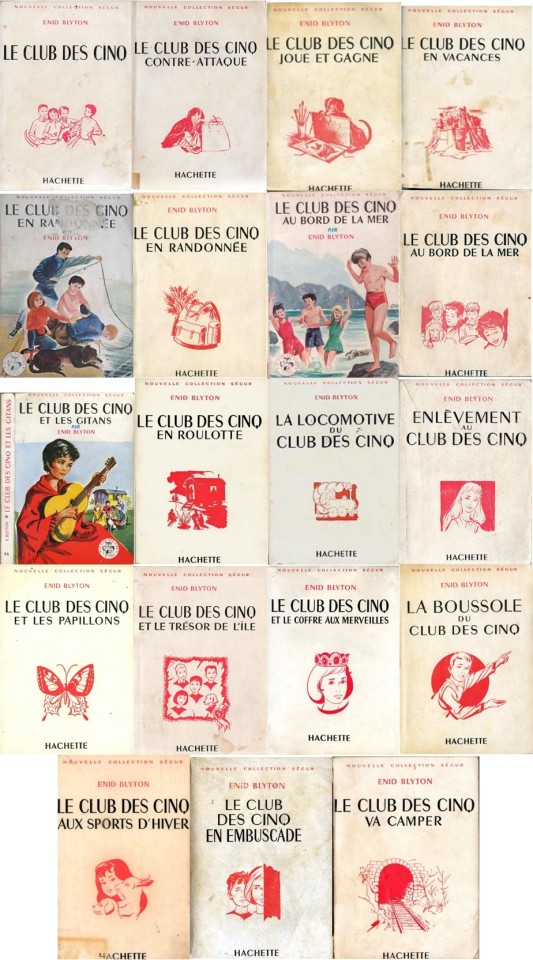
“Nouvelle Collection Ségur” – From left to right (in addition to the first six books which joined this collection at some point):
#10 Five on a Hike Together / Le Club des Cinq en randonnée (1958, ill. S. Baudouin);
#12 Five Go Down to the Sea / Le Club des Cinq au bord de la mer (1959, ill. Aldo de Amicis);
#09 Five Fall into Adventure / Le Club des Cinq et les gitans (1960, ill. Jeanne Hives);
#11 Five Have a Wonderful Time / Le Club des Cinq en roulotte (1960, ill. J. Hives);
#13 Five Go to Mystery Moor / La locomotive du Club des Cinq (1961, ill. J. Hives);
#14 Five Have Plenty of Fun / Enlèvement au Club des Cinq (1961, ill. J. Hives);
#16 Five Go to Billycock Hill / Le Club des Cinq et les papillons (1962, ill. J. Hives);
#01 Five on a Treasure Island / Le Club des Cinq et le trésor de l’île (1962, ill. J. Hives);
#18 Five on Finniston Farm / Le Club des Cinq et le coffre aux merveilles (1962, ill. J. Hives);
#19 Five Go To Demon’s Rocks / La boussole du Club des Cinq (1963, ill. J. Hives);
#17 Five Get into a Fix / Le Club des Cinq aux sports d’hiver (1964, ill. J. Hives);
#05 Five Go Off in a Caravan / Le Club des Cinq et les saltimbanques (1965, ill. J. Hives) [not featured];
#20 Five Have a Mystery to Solve / Le Club des Cinq et le vieux puits (1966, ill. J. Hives) [not featured];
#21 Five Are Together Again / Le Club des Cinq en embuscade (1967, ill. J. Hives).
If you count carefully, the 6 books from the “Ségur-Fleuriot” edition added to the 14 books from “Nouvelle Collection Ségur” make for a total of 20… out of 21 from the original English series! Where is the last book?? Well, the missing book (namely #15 Five on a Secret Trail / Le Club des Cinq se distingue) benefitted from a higher-end edition called “Idéal-Bibliothèque,” featuring a larger-size format, hard cover, better-quality paper, a dust jacket, and more numerous illustrations. A second book joined this upgraded edition a year later.
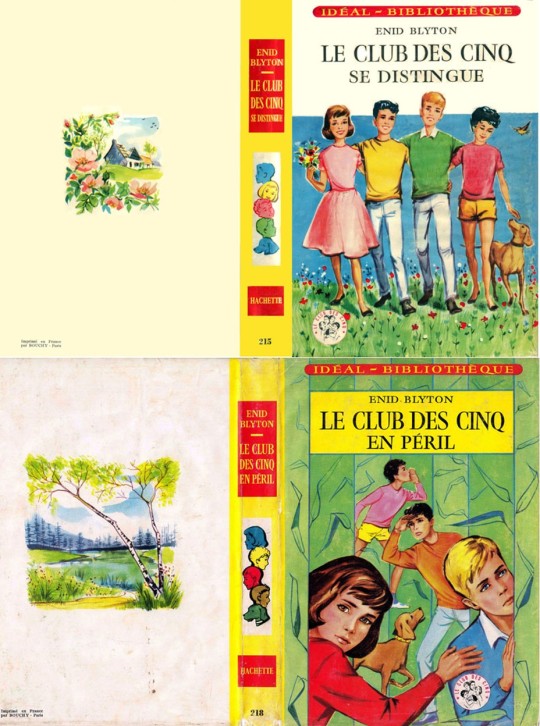
“Idéal-Bibliothèque” collection:
#15 Five on a Secret Trail / Le Club des Cinq se distingue (1961, ill. J. Hives);
#08 Five Get into Trouble / Le Club des Cinq en péril (1962, ill. J. Hives).
The “Bibliothèque Rose” editions, featuring hard covers, 4 to 6 full-page colour art, and several black and white illustrations, are the most well-known to this day.
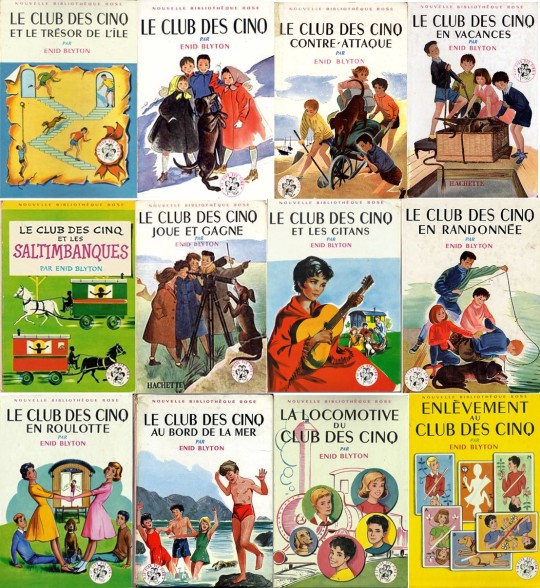
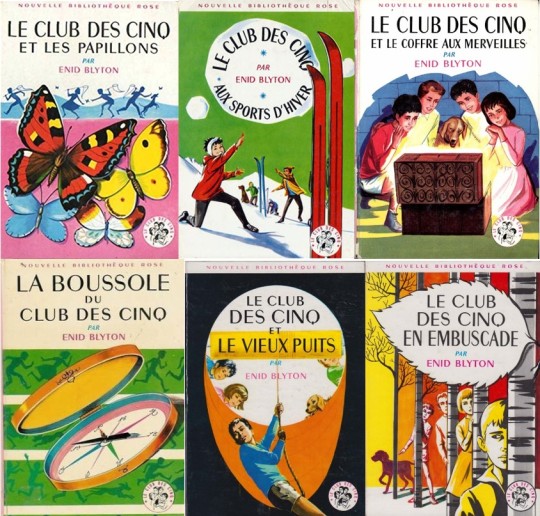
“Bibliothèque Rose” original editions from 1958 to 1967, featuring artwork from the four original illustrators
(Note: Covers sorted according to the original English publication order, as it is very difficult to pinpoint the exact French publishing order due to the many re-editions.)
The series became wildly popular and benefitted from several re-editions, some of them with new cover art produced by the then-current illustrator, Jeanne Hives.

Some “Bibliothèque Rose” re-editions from 1965-1969, featuring new cover art by Jeanne Hives
The 1970s saw a renewal of the “Bibliothèque Rose” collection with the arrival of illustrator Jean Sidobre who, over the next 15 years, produced numerous covers for all 21 books and, in time, produced the full set of inside illustrations. In these newer editions though, the number of full-page colour illustrations was reduced to four due to economic constraints.
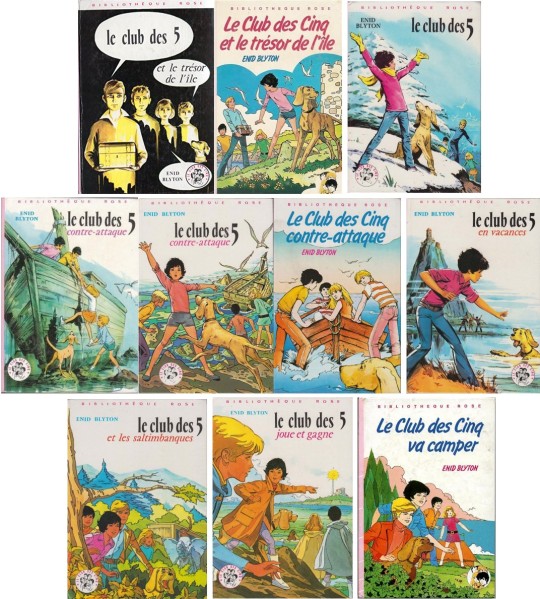


Various cover art by Jean Sidobre from 1971 to 1985
(Note: The third cover for '#03 Five Run Away Together / Le Club des Cinq contre-attaque' is not from Sidobre but from another illustrator, called Annie-Claude Martin.)
Back in the early 1970s, thanks to the series’ popularity, some of the books were published in a larger size format featuring several more colour illustrations and some black and white ones. These editions were respectively called “Galaxie” and “Vermeille” and were both illustrated by Jean Sidobre. Some of the art is the same as in “Bibliothèque Rose” above, and some is new. You will notice that the two books from the “Galaxie” edition are also part of the “Vermeille” edition; my guess is that they started these upgraded editions as “Galaxie”, but for some reason decided that “Vermeille” was better, and so they fitted the first two books into the developing new collection – as far as I can figure out, the contents of these two books are the same under “Galaxie” and “Vermeille”, the only difference being the cover art.

“Galaxie” collection:
#02 Five Go Adventuring Again / Le Club des Cinq (1971, ill. J. Sidobre);
#21 Five Are Together Again / Le Club des Cinq en embuscade (1972, ill. J. Sidobre).

“Vermeille” collection:
#18 Five on Finniston Farm / Le Club des Cinq et le coffre aux merveilles (1973, ill. J. Sidobre);
#21 Five Are Together Again / Le Club des Cinq en embuscade (1974, ill. J. Sidobre);
#02 Five Go Adventuring Again / Le Club des Cinq (1974, ill. J. Sidobre);
#01 Five on a Treasure Island / Le Club des Cinq et le trésor de l’île (1975, ill. J. Sidobre);
#17 Five Get into a Fix / Le Club des Cinq aux sports d’hiver (1975, ill. J. Sidobre);
#09 Five Fall into Adventure / Le Club des Cinq et les gitans (1975, ill. J. Sidobre);
#04 Five Go to Smuggler’s Top / Le Club des Cinq en vacances (1975, ill. J. Sidobre).
The 1980s saw a drop in “Bibliothèque Rose” sales as kids were moving from books to TV and video games. To boost sales, the publisher made several changes to the look and format of the books, and the original text was sometimes abridged.
In 1988, as sales continued to fall, and to save money, Hachette changed its “Bibliothèque Rose” hardbacks to a softcover pocket format. The inside colour illustrations disappeared and the black and white ones decreased in number (re-using former art from Sidobre). On the upside, these editions saw a series of new cover art from a different illustrator, Yves Beaujard, whose art style on these covers is very similar to Sidobre’s, which leads me to think that this was a requirement from the publisher who wanted a certain consistency between Beaujard’s cover art and Sidobre’s inside illustrations.
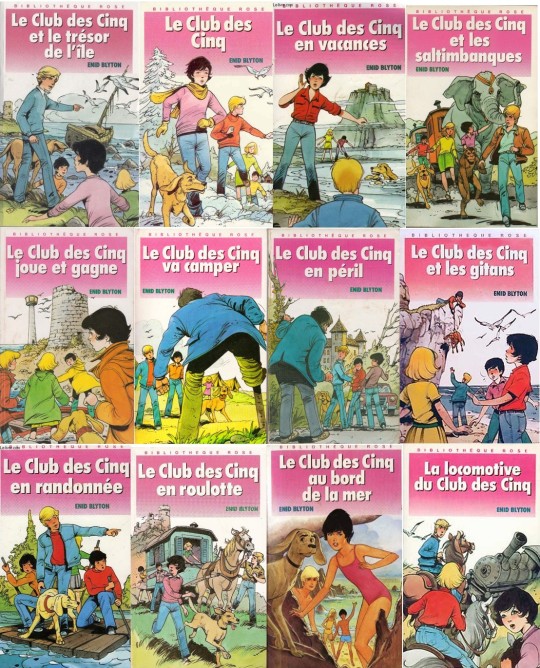

From 1988 to 1992, the whole series benefitted from new cover art by Yves Beaujard (with the exception of ‘Le Club des Cinq au bord de la mer’ and ‘Le Club des Cinq et les papillons’, which re-used former art from Jean Sidobre)
(Note: As far as I know, ‘#03 Five Run Away Together / Le Club des Cinq contre-attaque’ was never included in this edition.)
In the 1990s, a series of new cover art was produced by Paul Gillon, with the same general layout as the previous edition. The inside black and white illustrations are either former art by Sidobre or new art by Anne Bozellec.


Cover art by Paul Gillon from 1991-98
In 2000, Hachette celebrated the new millennium with a new style for its “Bibliothèque Rose” collection, featuring a hybrid format between hardback and softback adorned with a glossy aesthetic. The inside illustrations are the same as the previous editions, by Sidobre or Bozellec.


Cover art by Philippe Munch and Jame’s Prunier from 1999-2004
(Note: As far as I know, ‘#10 Five Go on a Hike Together / Le Club des Cinq en randonnée’, ‘#11 Five Have a Wonderful Time / Le Club des Cinq en roulotte’, ‘#12 Five Go Down to the Sea / Le Club des Cinq au bord de la mer’, ‘#17 Five Get into a Fix / Le Club des Cinq aux sports d’hiver’ and ‘#21 Five Are Together Again / Le Club des Cinq en embuscade’ were never included in this edition.)
In the mid-2000s, the morality police made their way through the books, resulting in watered-down translations and some title changes. Frédéric Rébéna did a series of new cover art. The inside illustrations all but disappeared, only featuring as small vignettes at the opening of each chapter.
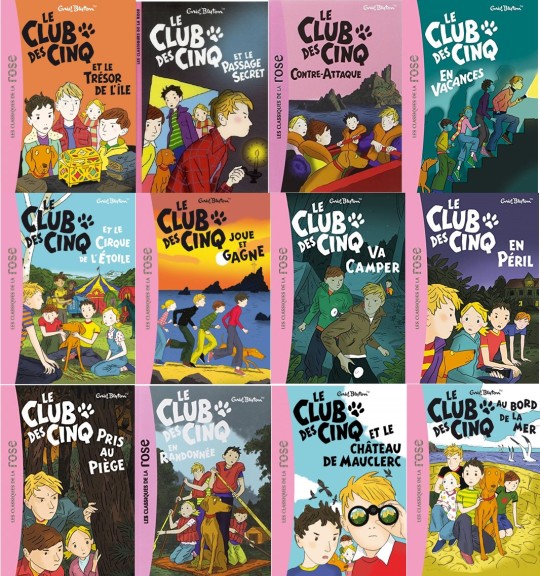

Cover art by Frédéric Rébéna from 2005-11
In the 2020s, the series changed from “Bibliothèque Rose” to “Bibliothèque Verte” collection with new cover art by Auren.
Similar to “Bibliothèque Rose,” “Bibliothèque Verte” (lit. “green library”) was another historically popular collection from publisher Hachette, initially aimed toward a teenage male readership, while “Bibliothèque Rose” was leaning toward a younger and female audience. Nowadays, the line between what is deemed appropriate reading material for boys or girls has thankfully blurred and both collections are now thematically oriented, “Bibliothèque Rose” focusing on humour/emotion and “Bibliothèque Verte” on action/adventure. Hence the marketing decision that caused the Famous Five series to lose its historical pink palette.

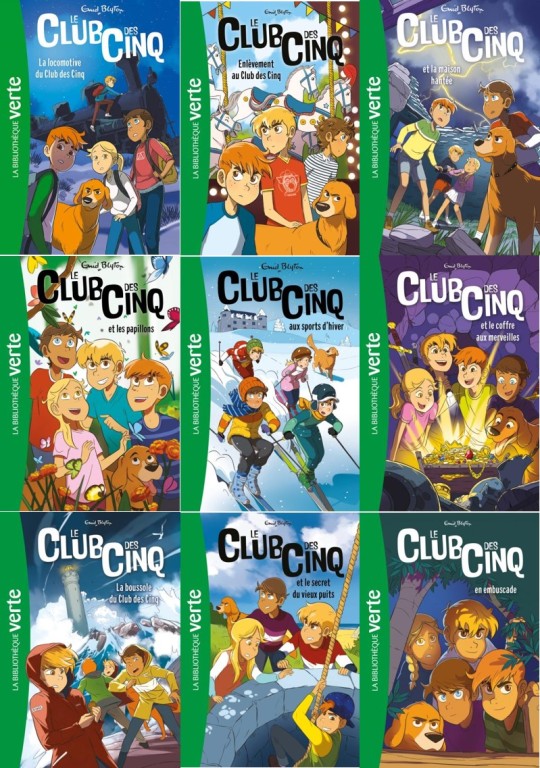
Cover art by Auren from 2019-21
And that’s a wrap for the main French editions! But there’s still a few more to go through.
First is France Loisirs, a book sales club to which you can register and you will receive a certain number of books each month. I do not know if the whole series was ever fully published by France Loisirs; the visuals that you will find below are all that I could find. The books are hardbacks with a dust jacket and without any inside illustrations. From what I could gather, they were published from 1975 to the early 1980s. The illustrator is called J.P. Morvan and, if you look closely, often took inspiration from earlier “Bibliothèque Rose” illustrations by Jean Sidobre.
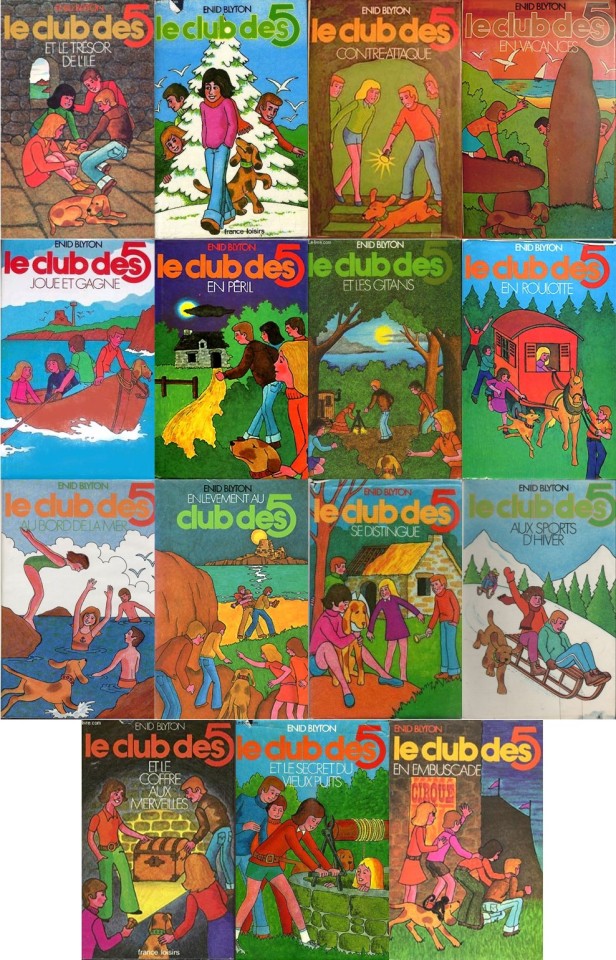
“France Loisirs” edition from 1975-82 with cover art by J.P. Morvan
In the 1990s, France Loisirs published another batch, re-using cover art by Paul Gillon from the contemporary “Bibliothèque Rose” edition. I’m a bit fuzzy on the exact dates, but these were published from the early to mid-1990s to around 2000. I do not know anything about the books themselves, but I can assume that they contain only plain text without any inside illustrations.
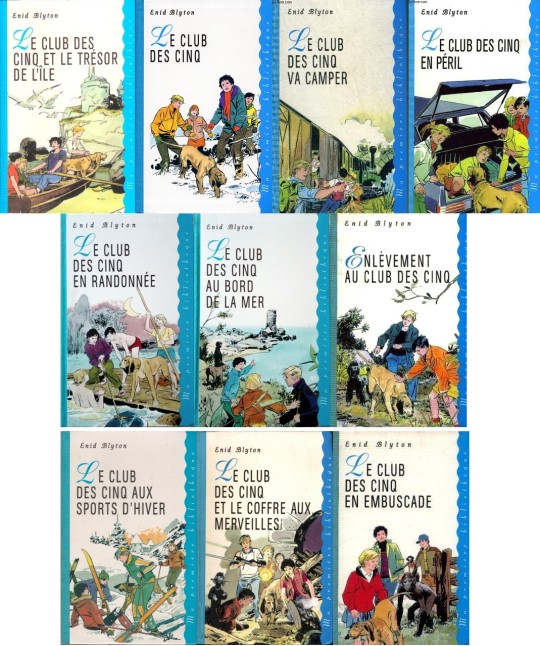
“France Loisirs” edition from the 1990s featuring art by Paul Gillon
Last on our exploration of “Famous Five” French publishing is actually not French at all! But I’m including it in this post because it uses the same French translations as Hachette.
This particular edition is from a publisher named “Edito Service SA, Genève”, which you may have guessed is from Switzerland. I don’t have a lot of information about its history and only learned about its existence because some of these books made it through the border into France, and from there onto the online second-hand market. The books each contain 5 illustrations by Umberto Nonna (3 black and white and 2 full-colour), and they come both in softback and hardback formats. They were published in 1981-82.
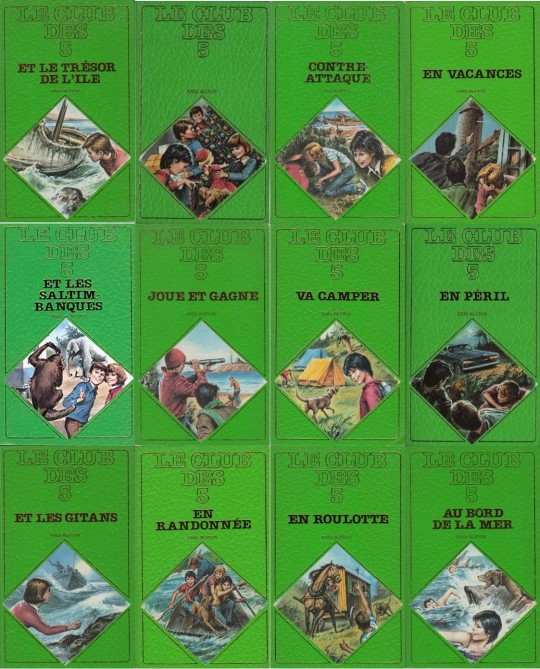
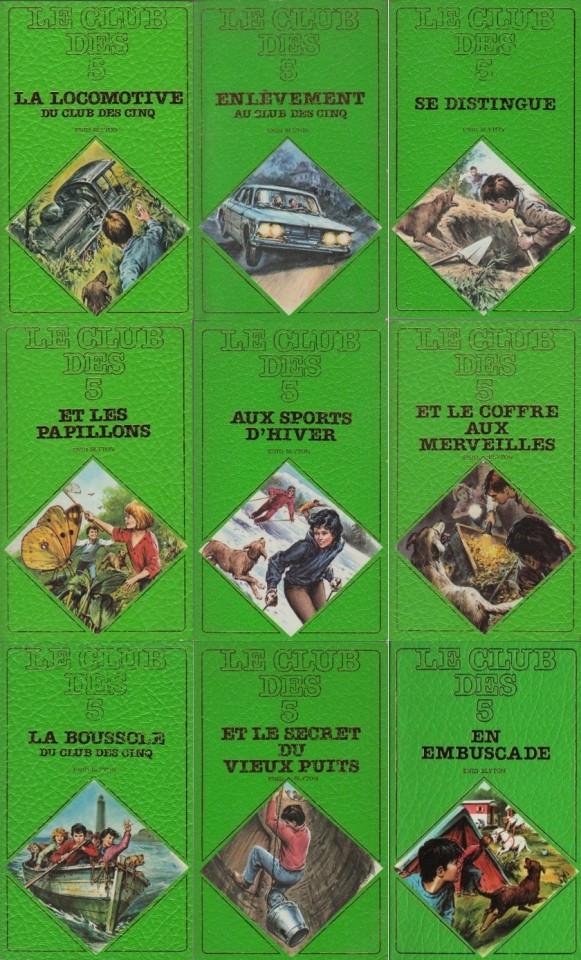
“Edito Service” edition from 1981-82 (softbacks)

“Edito Service” edition from 1981-82 (some of the hardbacks)
(Note: Despite what the above pictures suggest, all the hardback covers have the same dark green background.)
Thank you for your attention, and see you soon!
~~~~~~
We’ve now truly come to the end of this deep-dive into Famous Five French publishing.
#papillon82 reads#famous five art nostalgia#famous five#le club des cinq#illustrations#publishing overview#hachette#simone baudouin#paul durand#aldo de amicis#jeanne hives#jean sidobre#annie-claude martin#enid blyton#yves beaujard#paul gillon#anne bozellec#philippe munch#jame's prunier#frédéric rébéna#auren#jp morvan#umberto nonna#whew this post was a long time coming!#I have another post ready to go but I'd like to have more of a buffer before I resume my posting schedule#hopefully our regular posting schedule will resume next Sunday#until then have a great week!
8 notes
·
View notes
Text
Famous Five Art Nostalgia – Character Portrait: George [Claude]
Introductory post
Masterpost
Character profile (adapted from Wikipedia):
George is a tomboy, who demands that people call her George instead of Georgina; she cuts her hair very short and dresses like a boy. She is headstrong and courageous by nature and, like her father, has a hot and fiery temper. Introduced to the other characters in the first book, she later attends a boarding school with Anne. George has a loyal dog named Timmy who would do anything for her. She often gets cross when anyone calls her by her birth name or makes fun of Timmy, and she loves it when somebody calls her George or mistakes her for a boy.
In Claude Voilier’s continuation series ‘Les Cinq’, George takes an even more prominent role and is very clearly the appointed leader of the Five, superseding Julian’s position from the original series. Her boldness borders recklessness, and most of her endeavours, however risky, are rewarded with success. Like in the original series she is often taken for a boy and she enjoys it, but she’s also oddly quick to correct people by saying she’s actually a girl whenever this happens.

Eileen A. Soper, #06 Five On Kirrin Island Again, 1947
Click below for more portraits from every illustrator I could find!
(in chronological order)

Simone Baudouin, #02 Five Go Adventuring Again, 1955

Simone Baudouin, #03 Five Run Away Together, 1955

Simone Baudouin, #06 Five On Kirrin Island Again, 1956

Paul Durand, #07 Five Go Off To Camp, 1957

Paul Durand, #07 Five Go Off To Camp, 1957

Aldo de Amicis, #12 Five Go Down To The Sea, 1959

Jeanne Hives, #11 Five Have A Wonderful Time, 1960

Jeanne Hives, #15 Five On A Secret Trail, 1961

Jeanne Hives, #08 Five Get Into Trouble, 1962

Jeanne Hives, #19 Five Go To Demon’s Rocks, 1963

Jean Sidobre, #11 Five Have A Wonderful Time, 1974

Jean Sidobre, #05 Five Go Off In A Caravan, 1976

Claude Pascal, #LC14 Les Cinq vendent la peau de l’ours, 1977

Claude Pascal, #LC14 Les Cinq vendent la peau de l’ours, 1977

Claude Pascal, #LC15 Les Cinq aux rendez-vous du diable, 1978

Umberto Nonna, #06 Five On Kirrin Island Again, 1981

Umberto Nonna, #21 Five Are Together Again, 1981

Buci, #LC21 Les Cinq contre les fantômes, 1981

Jean Sidobre, #14 Five Have Plenty Of Fun, 1983

Annie-Claude Martin, #LC22 Les Cinq en Amazonie, 1983

Annie-Claude Martin, #LC24 Les Cinq contre le loup-garou, 1985

Yves Beaujard, #02 Five Are Together Again, 1990

Anne Bozellec, #LC01 Les Cinq sont les plus forts, 1991

Anne Bozellec, #LC02 Les Cinq au bal des espions, 1993

Paul Gillon, #01 Five On A Treasure Island, 1994

Philippe Munch and Jame’s Prunier, #01 Five On A Treasure Island, 1999

Frédéric Rébéna, #05 Five Go Off In A Caravan, 2006

Auren, #LC06 Les Cinq et les pirates du ciel, 2022
~~~~~~
Thanks for reading!
#papillon82 reads#famous five art nostalgia#famous five#le club des cinq#enid blyton#les cinq#claude voilier#character portraits#illustrations#eileen soper#simone baudouin#paul durand#aldo de amicis#jeanne hives#jean sidobre#yves beaujard#paul gillon#anne bozellec#philippe munch#jame's prunier#frédéric rébéna#auren#annie-claude martin#claude pascal#buci#umberto nonna
1 note
·
View note
Text
Famous Five Art Nostalgia – Introduction to ‘Les Cinq’
Main introductory post
After Enid Blyton passed away in 1968, French translator Claude Voilier wrote an additional 24 books as a continuation to the series. Published between 1971 and 1985, these books may not have quite as much success as the original series, but they are still being re-edited to this day. Eighteen of these books were then translated into English, while understandably never attaining Blyton’s popularity.
For copyright reasons, the continuation series was dubbed ‘Les Cinq’ as opposed to Blyton’s ‘Le Club des Cinq.’ Their first editions were within Hachette’s Bibliothèque Rose collection (about which you can learn more here). They bore Bibliothèque Rose’s trademark hard covers and included both colour and black-and-white inside illustrations. Unlike the original series, though, and possibly owing to the growing popularity of American comic books among France’s younger readership in the 1970s, the books offered a hybrid format featuring plain text on the left page and a comic strip summing up the main action on the right. This hybrid format disappeared when Hachette redesigned its Bibliothèque Rose collection in the late 1980s, opting for a softback format with scattered black-and-white illustrations throughout the text.
Voilier (thankfully) followed Blyton's general characterisation, while adding a few gimmicks. For example, it is clear that George was Voilier's favourite character and it seems that she can do nothing wrong, taking the lead in pretty much anything. Dick is hilariously foul-mouthed, and his language is often corrected by the ever proper Julian. Anne is sweet and a tad fearful, except when it counts and her bravery comes out (same as in Blyton's canon, really).
In the next few weeks and months, I intend to continue my ‘Famous Five Art Nostalgia’ series with posts for ‘Les Cinq’ featuring a detailed plot summary, all the full-colour illustrations and a selection of the black-and-white ones, as well as all the cover visuals I have been able to gather.
I hope you will join me as we discover the next adventures of our five investigators, who will occasionally take us on a trip throughout France, on a Mediterranean cruise, or even to faraway places such as Martinique, Brazil or India!
Credit to the illustrators:
Jean Sidobre illustrated the comic strips for 14 books in their original editions

Claude Pascal illustrated the comic strips for 7 books in their original editions

Buci illustrated the comic strips for 1 book in its original edition

Annie-Claude Martin illustrated the comic strips for 2 books in their original editions

Yves Beaujard did the cover art for 6 books in the series for the late 1980s/early 1990s edition

Paul Gillon did the cover art for the full series in the 1990s edition, with some new inside illustrations by Anne Bozellec while other books re-used earlier art from the former illustrators


Philippe Munch and Jame’s Prunier did the cover art for 9 books in the series for the early 2000s edition, with inside illustrations re-using earlier art

Frédéric Rébéna illustrated the covers of the full series for the mid-2000s/2010s edition

Auren illustrates the covers for the current edition (9 volumes currently published – ongoing)

#papillon82 reads#famous five art nostalgia#famous five#le club des cinq#les cinq#claude voilier#jean sidobre#claude pascal#annie-claude martin#buci#yves beaujard#paul gillon#anne bozellec#philippe munch#jame's prunier#frédéric rébéna#auren
0 notes
Photo

Welcome to 1968! Why not enjoy some PRUNIER-PRUNIER Extra Special at St. James Restaurant Ltd? http://menus.nypl.org/menus/26373
0 notes
